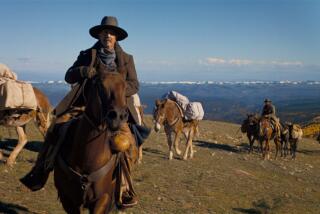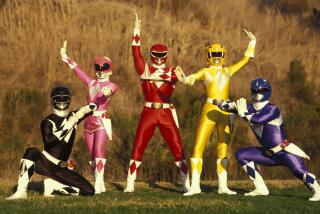Review: Not even Johnny Depp can rescue ‘The Lone Ranger’
- Share via
Within the memory of those still living, “The Lone Ranger” was a radio serial that broadcast 2,956 episodes over 21 years, as well as a beloved TV series that ran for an additional eight. Never in all that time was it thought necessary to have a villain who cut out human hearts and ate them, but, hey, these are different days, and even icons have to adapt or die.
It’s not clear whether the heart-eating episode was what producer Jerry Bruckheimer had in mind when he said he was going to introduce the ranger and his comrade-in-arms, Tonto, in “a fresh and exciting way.” In fact, the real problem with the new “Lone Ranger” is that, for those who are familiar with the multibillion-dollar “Pirates of the Caribbean” franchise, there is little fresh or exciting about what we have here.
More like “Pirates on the Plains” than anything else, “The Lone Ranger” was directed by Gore Verbinski (who directed three “Pirates” films) and written by Justin Haythe and Ted Elliott & Terry Rossio (who wrote all four). It’s got the same jokey tone, big stunts and weird characters of its predecessors, but even at an overlong two hours and 29 minutes, it lacks any compelling reason to come on board.
PHOTOS: ‘The Lone Ranger’ premiere
For though it cost the earth (an estimated $250 million) and involved enough men and material to invade a small country, “The Lone Ranger” exists without a convincing sense of jeopardy or, more critically, any place for audiences to emotionally connect. That TV show may have been modesty itself in terms of production values, but we cared about its heroes in a way we do not here.
Much has been made by the filmmakers about how this new version redresses the historic imbalance between the Lone Ranger and his Native American colleague Tonto by turning the erstwhile sidekick into a full-fledged crime-fighting partner. Although this may be true in theory, the reality is quite different.
Six-foot-five Armie Hammer certainly looks heroic, but to make room for Tonto’s exploits, his Lone Ranger character (civilian name John Reid) has been made into an incompetent tenderfoot. He’s a handsome fool who returns to his home in Colby, Texas, much like Jimmy Stewart’s character in John Ford’s classic “The Man Who Shot Liberty Valance,” with a belief in the power of the law over violence that is dangerously naive.
This might be fine if Johnny Depp’s Tonto were interested in being anything close to conventionally valiant, but anyone who’s followed this one-of-a-kind actor’s career knows this is invariably the furthest thing from his mind. And unlike his wonderfully insouciant Capt. Jack Sparrow in the “Pirates” franchise, Depp plays Tonto in a deadpan Buster Keaton style that is not well-suited to the demands of action and adventure.
VIDEO: ‘Lone Ranger’ Q&A with Johnny Depp, Armie Hammer
The tone of this under-the-top performance is set by “The Lone Ranger’s” decidedly odd framing device. The year is 1933, and a small boy in full Lone Ranger regalia enters a Wild West carnival side show and is understandably perplexed when a statue of “the Noble Savage” turns out to be an ancient but living human being. Who might this mummified individual be, so buried under layers of aging makeup that he looks as much like a tree as a person? It is Depp as Tonto, hiding from the camera one more time as he relates the Lone Ranger story.
Back we go to Colby in 1869, with railroad honcho Latham Cole (the always reliable Tom Wilkinson) proudly announcing that the railway, that iron road to the future, is about to arrive in town. On that very first train are eager law school grad John Reid, notorious desperado and traditional Lone Ranger enemy Butch Cavendish (William Fichtner) and, chained next to him, the inscrutable Tonto.
Waiting in town are hard-bitten Texas Ranger Dan Reid (James Badge Dale), who just happens to be John Reid’s older brother; Dan’s wife, Rebecca (Ruth Wilson), who just happens to be an old flame of John’s; and Red Harrington (Helena Bonham Carter), a madam who just happens to have a scrimshaw artificial leg fitted with a small revolver. It’s that kind of a movie.
Though turning Cavendish into a fiend with a taste for human flesh is a departure, “The Lone Ranger” does pay attention to the protagonist’s venerable origins story, as Reid survives a Ranger massacre, dons a mask and teams up with Tonto, though here that pairing makes neither one of them happy.
SET VISIT: Under the New Mexico sky with ‘Lone Ranger’
A decidedly odd individual in a painted face who is always feeding the dead crow in his headdress (a look inspired by a painting by Kirby Sattler), Tonto is presented as a member of the Comanche tribe who has reasons of his own to be interested in Cavendish and the railroad’s Latham, but by the time we find out what they are it is too late to care.
In addition to using the Cavendish name, this venture tips its hat to other aspects of Ranger mythology, including silver bullets, a horse named Silver and the phrase “kemo sabe.” It’s also good to see a big Hollywood feature shoot in Monument Valley for the first time in years, though it’s odd to be told the location has been moved to Texas.
And as satisfying as it is to hear snatches of Rossini’s “William Tell Overture” and hear a stirring “Hi-Yo, Silver,” it’s just as sad to report that although this Lone Ranger is good at helping strangers, rescuing his own film is beyond even him.
----------------------------------
‘The Lone Ranger’
MPAA rating: PG-13 for sequences of intense action and violence, and some suggestive material
Running time: 2 hours, 29 minutes
Playing: In general release
More to Read
Only good movies
Get the Indie Focus newsletter, Mark Olsen's weekly guide to the world of cinema.
You may occasionally receive promotional content from the Los Angeles Times.








